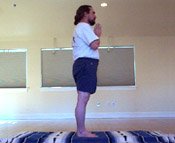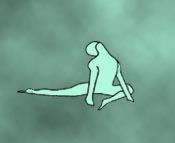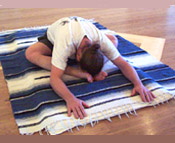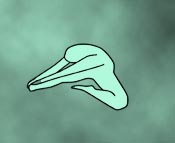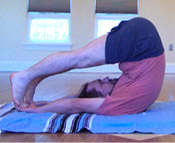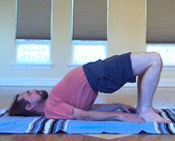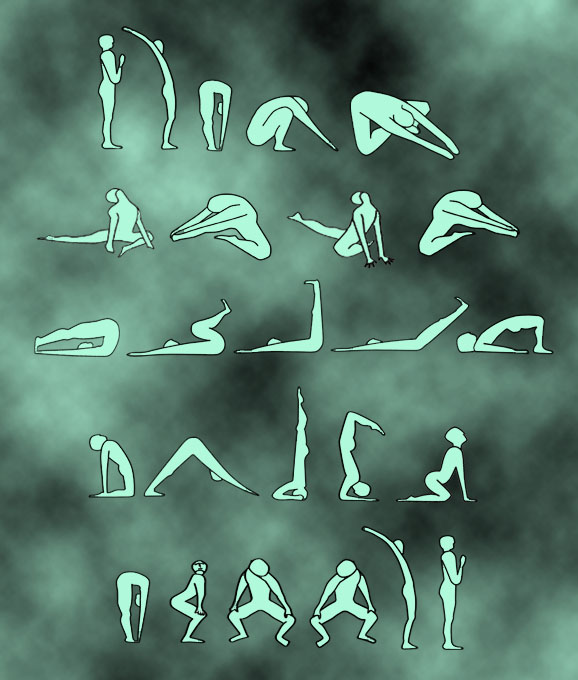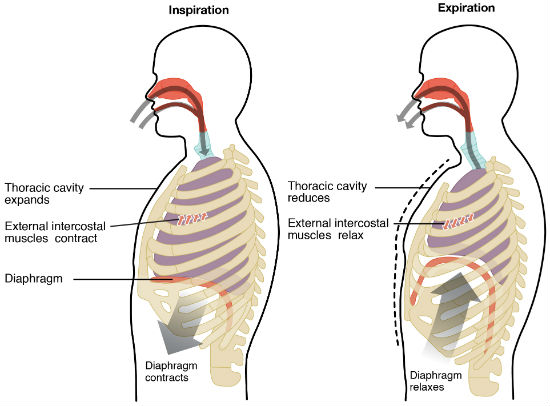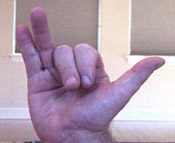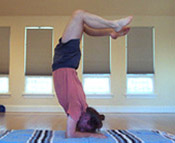
HATHA YOGA | BODYAWN
Everyone knows how satisfying a good yawn feels, and how refreshing it can be. When we yawn, our bodies are doing yoga involuntarily. An unconscious impulse arising from oxygen-hunger triggers a stretching in the mouth and breathing system, flushing the skull with fresh, oxygen rich blood, and heightening our mental focus and clarity.
Hatha Yoga is an ancient, systematic practice for re-creating the "yawn-experience" throughout every part of the body. Every muscle, sinew, and tendon in the body is "put through its paces" - flexed, stretched, and relaxed.
Our most basic need is oxygen, it is our most basic 'fuel.' Every cell in our bodies, especially the brain, craves oxygen. Yogis speak of "Prana," which means many things, but on the most mundane level, it means "Oxygen." The Yogic science of Pranayama is a system for maximizing the body's efficent absorption and utilization of oxygen. Here is more about Pranayama.
Yoga postures are a form of exercise that is unlike many western forms of exercise. Most yoga is not aerobic, that is, it doesn't raise the heart/breathing rate to the high levels that running, swimming, or dancing will do. Yoga also does not aim to create showy muscles or feats of gymnastics.
Instead, yoga combines flexing, stretching, and relaxing, often all at once in the same pose. Though contemporary American styles often embrace a calesthenic or aerobic approach, the Kripalu style I use is done at a slow, meditative pace, with emphasis on calmness and strength. A simple yoga routine done for a few minutes daily can be life-transforming.
After 23 years of daily practice, I have been blessed
to have these days, anyway, a daily practice that extends to an hour, often twice a day. It blossoms!
BEGINNING YOGA Those lucky enough to start doing yoga as children enjoy lifelong flexibility, freedom of movement, and strength. The native flexibility of youth can be captured and sustained for as long as the person keeps doing yoga. Those who start later in life can work towards recovering some of the suppleness of youth - and it's never too late to start. Children have great flexibility, and only need to gain a bit of strength to be fluent yogis. At puberty, the body already begins to lose important flexibility, starting with the hamstrings. (The tendons that run up and down the backs of the legs.) Most people, by the age of 20, are already unable to touch their toes. Yoga must be done with care. With the intense focus on specific ligaments or muscle groups, a mistake or slip can cause painful injuries that can stop your progress in its tracks. The Kripalu style of yoga discussed here relies fundamentally on the person's sensitivity to their own body's messages. A pose is taken only as far as is comfortable, never to the point of pain. It's not about trying to look exactly like a picture in a book, or in forcing the body into a precise angle or position. The postures (asanas) shown here and in most yoga books and websites are idealized, that is, they are how a flexible, strong yogi does them. It's dangerous to try to force the body into one of these positions if you're not ready, and doing so can cause injury. Asanas shown in books and so forth show the goal, what is being gently worked towards. BASIC NECESSITIES Of prime importance is the surface on which you do your yoga. The optimal surface is a solid pad of some sort, that softens the hardness of the floor, while providing a firm base for balancing. Avoid hard surfaces at all costs - even if you know what you're doing, doing yoga on a hardwood floor or concrete can cause serious injuries. Blankets can work if need be - the ideal surface is about like average carpeted floor with thick padding. The hardwood floors popular today are a mystery to me personally - it seems counter-intuitive that one would put all one's weight on a joint pressing into a totally resistant surface. Another important
factor is the space in which you practice. The space should be inspiring. If you can
manage a beach, or a mountaintop ashram, or a mountain lake, wonderful! But that's not
always possible. For several years I
was compelled to do my daily practice in an industrial hallway by the floor cleaning machines,
but it didn't stop me. What I learned from that experience is how to use my imagination, close
my eyes and do my asanas on an inner mountain meadow.
When at a better time I found myself in a tropical paradise, I opened my eyes to find the
inner visions had taken physical form...
It's also important to have enough room front, back, and to the sides. Getting into a regular practice can cause a person to re-organize their whole living space - just one of the ripple benefits of doing yoga. To do your routine, you should not have a full stomach, or be really hungry. You should have taken care of all bathroom needs, and should not do yoga where it's really cold, or really hot. (There is a form of hot yoga, that should be done with supervision). The most effective (and of course the most difficult) time to do yoga is early in the morning. The resistance and obstacles to this are almost infinite - but not insurmountable. The fact is, a simple daily routine of 15 minutes a day in the morning can change your life, and 15 minutes is a surprisingly short amount of time. The body is looser in the evening, but by then motivation can be an even bigger problem. Whenever you do your Vinyasa (routine), know that the most important thing is regularity. A short daily routine is substantially better than sporadic full-hour workouts. Of course, long workouts are extremely valuable, if you can make the time. With a daily practice, progress can seem very slow, but when gains are made, they are firmly embedded. RELAX, BREATHE, RELAX SOME MORE Relaxation is a science requiring careful attention, patience, and practice. It usually takes several 'levels' to get really relaxed. Quite often, we think we're relaxed, but then upon reflection, realize that we have a shoulder clenched, or that our back is bunched up. Many people wake up during their sleep with various muscles clenched, resulting in cramps, jaw grinding (bruxism) and bad sleep in general. Muscles are made to be 'cycled' - that is flexed, stretched, and relaxed. When a muscle is denied this function, it reacts by first weakening, then stiffening, and then spasming, often during sleep. The restlessness of insomnia is that the mind is tired, but the body is not. The body wants to be worked. Most people only use a few of their muscles and tendons on a day to day basis, driving or sitting in front of computers, and so have bodies full of muscles craving to be exercised. Many contemporary exercise systems create other imbalances, overworking certain areas and neglecting many others. There are muscles that are vital for avoiding back problems that most people don't even realize exist. While blasting your triceps might be fun, its also important to keep those complex and delicate lower back muscles healthy. (Which yoga does.) Because yoga systematically works, relaxes, and oxygenates every muscle / tendon group in the body, it is immensely therapeutic for all kinds of physical ailments. It is also totally compatible in combination with other physical arts and exercise techniques. Another benefit of yoga is on the inner organs, from the twisting poses, which massage, stretch, and flex them, oxygenating them and helping them to release toxins and blockages. An important feature of the vinyasa [routine] is the relaxation phase of each pose. Even if the yogi chooses to move swiftly from one pose to the next, at each complete posture, there is a moment of "stopping the world" - that is, breathing deep, centering, slacking the unused muscles (see below), and pausing. This is the "grace point," or the "gravity point," or the "moment of becoming a statue." LET THERE BE SLACK Most yoga poses involve holding some muscles flexed to keep the body in the position. What is of equal importance is to pay attention to the muscles that are needlessly flexed at these times. While in a posture, at the pause point (see above), mentally peruse your entire body, distinguishing between the muscles that you need to hold the position, and the muscles you don't need to hold the position. It's often surprising what you'll find. And when you relax the needlessly flexed muscles, you find that they are the most in need of stretching. The muscles needed to maintain the asana are like telephone poles - everything else can hang like the lines and be totally slack - so in fact, yoga is a deeply relaxing form of exercise. A muscle cannot flex and stretch at the same time. A fully slack and relaxed muscle can fully stretch, and so when you relax those unconsciously tensed muscles, the stretching benefits are enhanced. A muscle that has not been stretched enough will react by flexing, to avoid the unfamiliar activity. Great care must be used at these moments. Slow (way) down. Breathe deeply, and focus your mind on the area of resistance. Breathe into the edge of the pain, and 'ride' the limits of your comfort level. Be slow, careful, and respectful as you move out of the resistance as well. When in these meditative/healing moments of yoga, any sudden movement can wreak havoc. This is when you can spend ten minutes in a pose. THY SPINE IS THE BASSLINE Like a root sprouting down from the brain, the spine is the core of our bodies, and as such, it should be carefully tended, strengthened, and protected. Every part of the body has a holistic relationship with the spinal column, and when the back is out, everything else suffers. The hamstrings are crucial to good back health, even though they are part of the legs, a prime example of the interrelatedness of the body. These long tendons connect with and provide foundation for the entire body, especially the back. Imagine a bungee cord reaching from the crown of your head to your heels, and that is the territory in question. The upper back has a special relationship to the neck, shoulders, and yes, hamstrings. Besides the perennial advice to keep the hamstrings stretched, Neck Rolls are vital for keeping the upper back healthy, and are the first and simplest yoga exercise to begin with. NECK ROLLS Neck rolls should be done SLOWLY - imagine how fast a sunflower follows the sun, and shoot for that. Start by sitting with an erect spine. Let the head loll forward. Breath deeply, using Square Breathing, and slack every muscle not absolutely necessary to maintain the position. As the head begins to roll to one side, be especially aware of shoulder muscles on both sides of the rotation, which will try to clench. Imagine that the arms are wet socks filled with sand, loose and dangling, and this will help the shoulders relax. At the "9 o'clock" position, imagine trying to touch your shoulder with your ear. At each microscopic advance in the rotation, be alert for needlessly clenched muscles. When the head is rolled back, looking at the ceiling, allow the jaw to go slack, letting the mouth gape wide open. As ridiculous as it sounds, rolling the eyes back and following the line of the bend adds to the benefit. These must be done with Great Care, especially if you are new to it. You will probably hear some popping at first. The complex array of muscles surrounding the neck and upper back benefit immensely from these exercises, but if they have been untended, they can do some flinching you won't enjoy. The key to avoiding spasms is to slow down, breathe deeply, and work with the area of resistance. [An added benefit of neck rolls is that they prevent the deep wrinkle lines many people get on their necks as they age.] After neck rolls, the rest of the yoga series can begin. Here is a more detailed look at each asana. OBSTACLES The younger you are, the easier it will be for you to take up yoga. You need it more as you get older, so it really is an investment in your own future to learn early, when you don't even know what older people talking about when they say "aches and pains." If you're over 12 or 13, you are already losing flexibility. Depending on habits and conditioning, adults are confronted with a variety of obstacles to developing a yoga practice. Weight is probably the biggest problem. Excess weight restricts freedom of movement, not only making it difficult to do yoga, but also causing a myriad of other problems. Yoga cannot cure a weight issue, but it can be a motivating factor in solving the issue. Another issue is the inability to complete a yogic "circuit." This means that if you can't grab your toes with your fingers while your knees are locked, for example, you won't be able to relax certain muscles. [One solution is a strap - a strip of canvas or similar material that provides suspension allowing the "circuit" to be completed.] Until you get that suspension, you won't get the full reward of the asana because of the straining involved in holding the position. Don't hesitate to ask for one in class, because they are an ancient and honored custom. "A Regular Practice" Getting regular with yoga is another hurdle everyone confronts. Unless you live in an ashram, it's hard to do 90 minutes of yoga every morning. I had attended so many hour or hour and a half yoga classes and somehow felt I had to try to reproduce that every day. As a typical over-scheduled working person, I found it was impossible, and would skip it altogether. That didn't work either, so I made a compromise, and do a little bit every day. The vinyasa above can be done in 12 to 15 minutes, and sometimes that's all I have. The point is to go through the series every morning, no matter what. If you add it up, at the end of the week you've done two hours of yoga, and like the slow, microscopic additions of nacre on a growing pearl, your progress grows in a big way. Go to a 1 or 2 hour class as often as you can, extend your morning practice at every opportunity, but make that gesture to the Guru Within every morning, even if it's a quick one. Think of the story of the Tortoise and the Hare. The tortoise takes small, slow, persistent steps, while the hare runs in irregular big bursts. Biting off more than he can chew, the rabbit loses momentum, but the turtle paces himself, and wins the race. OUCH! Injuries are a different kind of problem. There are yoga teachers who specialize in working with injured people, and it is recommended to find one if you have severe problems. Yoga is often the best therapy for an injury, but must be done with great care. Injuries make it obvious how inter-connected the body is. A torn ligament or back spasm has a 'ripple effect' throughout the body, often triggering pain in seemingly unrelated areas as it is worked out. During the healing process, "waves" of kinked muscle radiate from the initial problem, as the trauma works its way out of the body. By the same token, treating one part of the body to some yoga can help other parts immensely. For example, keeping the hamstrings supple has a wonderful effect on the upper and lower back. Another way this is demonstrated is that when you notice an unconsciously tensed muscle, and relax it, often a completely different part of the body will suddenly "show up on the radar." Of special concern are injuries sustained by the over-enthusiastic beginner. Muscles and joints unused to being worked can react in various ways, not all pleasant. Initial progress can breed overconfidence, increasing the chance of an injury. For this reason, it's good to start small. Gradual development will last longer, while an injury from overdoing it can set a person back months or years. When encountering resistance in doing a yoga pose, or when working with a strained area, remember to breathe deeply, slow down, and focus on every muscle and tendon. Appoach the pain, tension or resistance respectfully, tenderly. Visualize your prana flooding the sensitive area with vital curative energy. Gentle rocking or slight rocking rotations ease the way. Work with it, never forcing, and let the healing begin. THE GURU WITHIN Your sinews, muscles and organs - the wondrous biological-computer-machine that you occupy, is your Guru. We could call it the "Body Guru" or the "Inner Guru." Of course it's a metaphor, or a poetic stretch - but after all, the body does meet many of the definitions of "Guru." Like a guru, your body knows all of your inner secrets, you care for your body's safety before anything else, your body gives you messages, warnings, and rewards, your body is there for you while you sleep, and your body guides you in caring for it. Yoga is an offering - giving your body 15 or 25 minutes of yoga every morning is like bringing flowers and fruit to your beloved Guru - once you realize this, how could you possibly neglect such a holy opportunity? Adding this awareness to your practice can sweeten it too, encouraging you to re-arrange your life so that you don't have to rush your morning vinyasa. When there is resistance, when the hamstrings up and down the backs of the legs don't want to let you touch your toes, thats your Guru saying: "relax, stretch, breathe, open." When your arms want to stretch out to the sides during a pose, the Guru is encouraging you to try a variation - to open the shoulders from a slightly different angle. Like finding the perfect position during sleep, the body-guru knows its business. Allow yourself to vary the postures to what feels the best. Use the asanas as a guide, knowing that there are countless variations to each pose. Develop a relationship with your body, listen and trust.